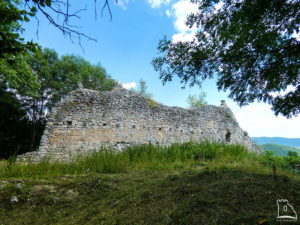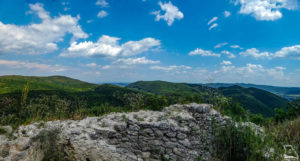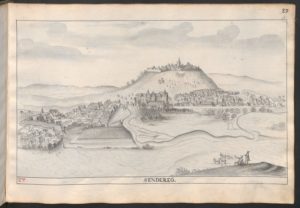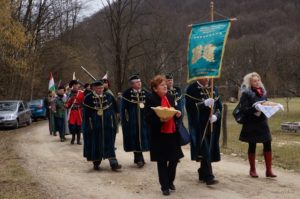Szádvár

Szádvár is located in the northeastern corner of Hungary, at Szögliget, in the Aggteleki Mountains. It has the largest area among those Hungarian ruined castles that stand on hilltops. The castle now is famous for the people who are trying to restore it, they are the “Friends of Szádvár”. Their outstanding efforts deserve our respect.

Here are two videos about the castle, the first one was made by Fodor Zsolt:
https://www.youtube.com/watch?v=QaH6bnaCxNc
and here is another one about the ruins:
https://www.youtube.com/watch?v=j1PgLc5AQHg

Szádvár was built before 1264 by King Béla IV. The castle was first mentioned in 1264 as “Szárd”. At this time, its captain was Bács who opened the castle’s gates before the troops of King Béla IV during his war against his son, István. King Kun László traded the castle in exchange for the castle of Jenő of Nógrád County and the new owner became Comes Tekes of Sáros County.

The area was occupied by the troops of the mighty Aba Amádé oligarch around 1301 but the castle was returned to the king in 1319. Its captain was Lack, the son of Bárcai „Fekete” Miklós. Comes Drugeth Fülöp gave the leadership of the castle to Péter in 1323. Bertalan, the son of Pongrác was the captain between 1335-1338. (Please, note that I use the Oriental name order for Hungarians where family names come first.) Baron Drugeth Vilmos was in command in 1339 and his vice-captain was Lengyel Péter. The captain became Master János, son of Szobonyai in 1360, appointed by Palatine Raholcai Kont Miklós.

The Bebek family got the castle between 1387 and 1392 because they helped King Zsigmond to gain his throne. The Bebek family members appointed three captains at the same time in 1414 to command the castle (as a rule, two captains were appointed), namely Kis Jakab, Olcsvári András, and Csányi András. They were replaced by Paris Jakab and Gicei Jakab in 1419.

Queen Erzsébet called the Bohemian Hussites to the country to support her reign after 1440. It was when a Polish robber knight, Péter Komoeowsky gained the castle and held it for the Hussites. Szádvár was given back to its lawful owners in 1454 by Baron Péter.
Later, Szapolyai Imre, Count of Szepes, wed Lady Bebek Orsolya in 1470 so Szádvár went to the Szapolyai family.

Szapolyai János, the Voivode of Transylvania was elected as king of Hungary after the Battle of Mohács in 1526. The new king gave Szádvár and Torna castles to Werbőczy István. The new owner couldn’t take Szádvár over because the captain of Szádvár, Trinnay Lengyel Gergely tricked him and ceded the castle to Bebek Ferenc who was supporting King Habsburg Ferdinand. Soon, Werbőczy resigned from the ownership of Szádvár and gave it to the Treasurer, Tornallyai Jakab but this act didn’t change the situation.
Bebek Ferenc preferred to look at his interests during the anarchy of the Dual Kingship and he has changed sides several times. In the meantime, he carried out significant construction work and fortified the castle. He built the round bastions for the cannons on them. The Bebek family owned a great part of the Hungarian Highland and they were the lords of Krasznahorka, Szendrő, Csorbakő, and Torna castles as well. Their troops soon took the Monastery of Gombaszög and fortified it.

Bebek besieged the castle of Fülek in 1562 but he was betrayed and the Turks captured him. He was released only three years later but he had to take the side of the Transylvanians in exchange for his freedom. King Ferdinand just could not let it happen unpunished, and the Chief Captain of Kassa (Kosice, Kaschau), Lázár Schwendi besieged Szádvár in January 1567. Bebek Ferenc was away so the castle’s defenses were commanded by his wife, Lady Patócsy Zsófia. But let us learn more about her:
Lady Patócsy Zsófia (1533-1583)






The area of Szádvár with its 19 villages went to the king who didn’t have the castle restored. The Military Council of Vienna decided in 1577 to restore Szádvár and Krasznahorka castles and they gave 1000 gold Forints for this reason. We don’t know whether it was carried out in reality, though. The Chief Captain of Kassa, Rübert János got Szádvár under the condition that he should repair the walls. When he died in 1593, Dersffy Ferenc inherited the castle with the same obligations.

Chief Captain of Kassa, General Basta promised to give Szádvár to Csáky István around 1600 but he couldn’t pay for it. This way the castle was given to Hetesi Pethe László. The guards of Szádvár fled from the castle in 1604 when they saw that the stronger Szendrő castle had opened its gate to the army of Prince Bocskai István of Transylvania. However, according to the Treaty of Vienna, Szádvár and its villages were returned to the Csáky family in 1606. There were only 50 infantrymen and two artillerymen in the fort in 1607.
Báthory Gábor became its new owner and from him, the castle went to Rákóczi Zsigmond in 1608. Rákóczi gave the throne of Transylvania to Báthory Gábor at the same time, and Rákóczi passed away during the same year. Then, the Court of the Palatine gave Szádvár back to Hetesi Pethe László. The Rákóczi, Csáky, and Pethe families were suing each other for a long time and debating over the ownership.

The garrison of Szádvár opened the gates before Prince Bethlen Gábor of Transylvania in 1619 but the castle was given back to the Habsburgs in 1621 according to the Treaty of Nikolsburg. Yet, the garrison opened the gates again before Bethlen in 1623-24.
The Imperial troops moved to Szádvár in 1626, after the Peace of Pozsony (Bratislava, Pressburg). Things were different in 1644 when the garrison was fighting heroically against the Transylvanian besiegers. Later, the Hungarian soldiers of Szádvár were attacking the supply lines of the Transylvanian army. The Transylvanian army left the area only at the end of the year, unsuccessfully.

It was again a different situation in 1675 when the unpaid imperial soldiers ceded the castle to the rebel Kuruc troops of Baron Wesselényi Pál who was supported by the Transylvanians. However, General Strassaldo took Szádvár back during the summer of 1675. The “Kuruc” (=rebel) troops of Prince Thököly Imre gained control over the fort in 1682. When the Polish King Ján Sobieski defeated the Turks at Vienna in 1683, his army was sacking and burning the valley of the Bódva river while returning home. The local folklore calls the event a “lengyeljárás” or “Polish devastation”. The Polish didn’t attempt to besiege the castle, though. The rebel “Kuruc” troops were firing them with cannons but they could not stop the plunder.

The same “Kuruc” garrison surrendered the castle in 1685 to General Caprara. The Imperials exploded the most important walls and bastions so the military function of the castle ceased to exist anymore. The forest became the next owner of the ruins.
There was a village called Derek next to the hill of Szádvár castle. The plague killed its inhabitants in 1711 so Polish people were invited to live there. The new settlers used the stones of the old castle for building their homes as it usually happened to every abandoned castle in the Carpathian Basin.

Sources: Szibler Gábor and https://www.szadvar.hu/
Dear Readers, I can only make this content available through small donations or by selling my books or T-shirts.
If you like my writings, please feel free to support me with a coffee here:
You can check out my books on Amazon or Draft2Digital, they are available in hardcover, paperback, or ebook:
https://www.amazon.com/dp/198020490X
or at https://books2read.com/b/boYd81


My work can also be followed and supported on Patreon: Become a Patron!http://Become a Patron!

[wpedon id=”9140″]
Here are more pictures of Szádvár:















































